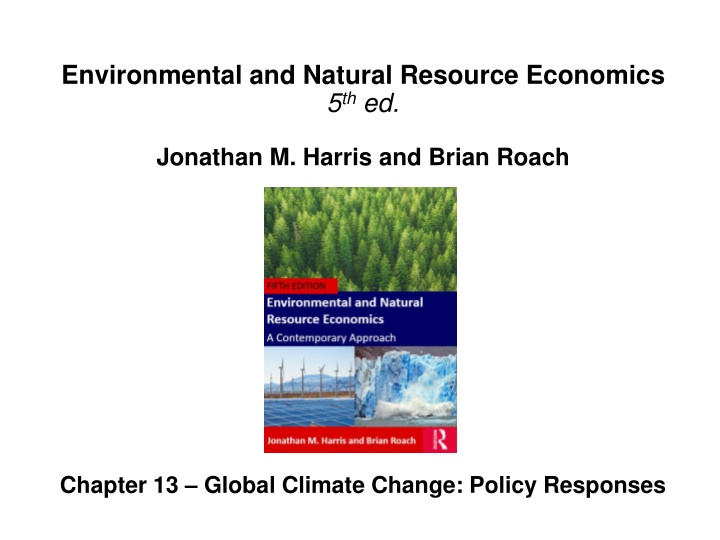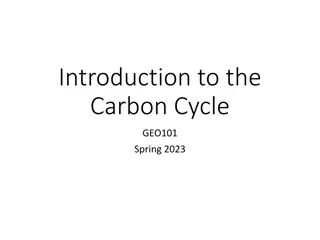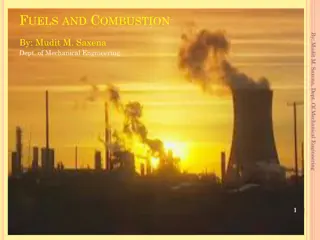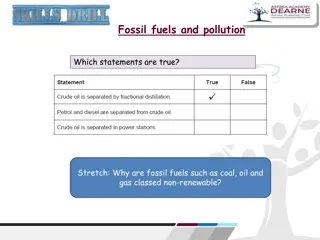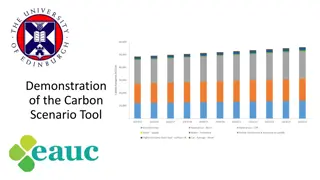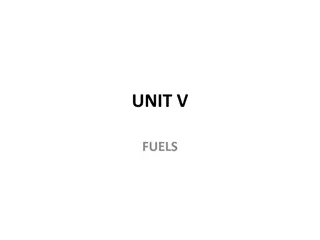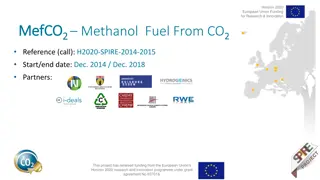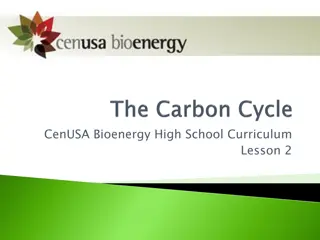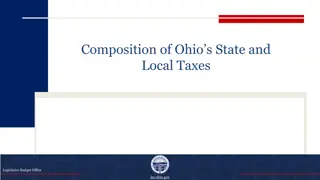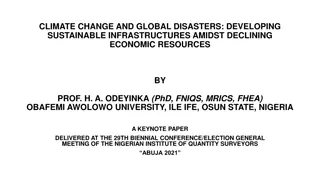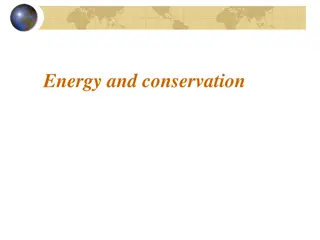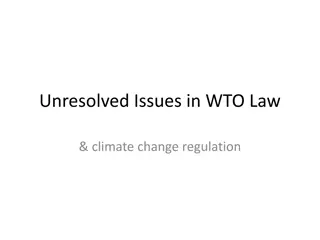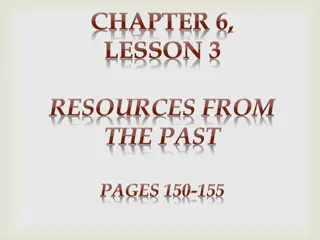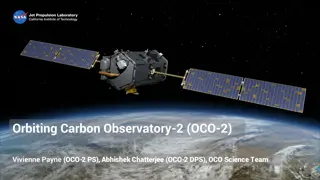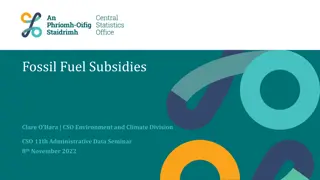Policy Responses to Global Climate Change: Alternative Carbon Taxes and Impacts on Fossil Fuels
The chapter discusses the implementation of alternative carbon taxes on fossil fuels and their effects on retail prices of gasoline, coal, and natural gas. It provides insights into the impact of carbon pricing on emissions, retail prices, and consumption patterns, emphasizing the importance of carbon taxation in addressing climate change.
Download Presentation

Please find below an Image/Link to download the presentation.
The content on the website is provided AS IS for your information and personal use only. It may not be sold, licensed, or shared on other websites without obtaining consent from the author.If you encounter any issues during the download, it is possible that the publisher has removed the file from their server.
You are allowed to download the files provided on this website for personal or commercial use, subject to the condition that they are used lawfully. All files are the property of their respective owners.
The content on the website is provided AS IS for your information and personal use only. It may not be sold, licensed, or shared on other websites without obtaining consent from the author.
E N D
Presentation Transcript
Environmental and Natural Resource Economics 5th ed. Jonathan M. Harris and Brian Roach Chapter 13 Global Climate Change: Policy Responses
Table 13.1: Alternative Carbon Taxes on Fossil Fuels Impact of Carbon Price on Retail Price of Gasoline Impact of Carbon Price on Retail Price of Coal kg CO2 per gallon 8.89 kg CO2 per short ton 2100 tonnes CO2 per gallon 0.00889 tonnes CO2 per short ton 2.1 $/gal., $50/tonne tax $0.45 $/short ton, $50/tonne tax $105 $/gal., $100/tonne tax $0.89 $/short ton, $100/tonne tax $210 Retail price (2021) per gallon $2.20 Retail price (2021) per short ton $50 % increase, $50/tonne tax 20.5% % increase, $50/tonne tax 210 % increase, $100/tonne tax 420 % increase, $100/tonne tax 41% Source: Carbon emissions calculated from carbon coefficients and thermal conversion factors available from the U.S. Department of Energy. All price data from the U.S. Energy Information Administration.
Table 13.1: Alternative Carbon Taxes on Fossil Fuels Impact of Carbon Price on Retail Price of Natural Gas kg CO2 per 1000 cu. ft. 53.12 tonnes CO2 per 1000 cu. ft. 0.05312 $/1000 cu. ft., $50/tonne tax $2.66 $/1000 cu. ft., $100/tonne tax $5.31 Retail price (2020) $12 % increase from $50/tonne tax 22.2 % increase from $100/tonne tax 44.4 Source: Carbon emissions calculated from carbon coefficients and thermal conversion factors available from the U.S. Department of Energy. All price data from the U.S. Energy Information Administration.
Figure 13.1Carbon Content of Fuels 120 100 kg CO2 per million Btu 80 60 40 20 0 Coal Oil Natural Gas Source: Calculated from U.S. Department of Energy data.
Figure 13.2Impact of a Carbon Tax on Gasoline Price CO2 With a price of $2.20/gallon, this raises prices by 20% Carbon tax of $50/tonne = $0.44/gallon One gallon of gasoline = 8.89 kg of CO2 (0.009 tonnes) Source: Calculated from U.S. Department of Energy data.
Figure 13.3Gasoline Price Versus Consumption in Industrial Countries, 2016 8 7 Iceland Price ($US per gallon) 6 New Zealand Turkey Switzerland 5 Luxembourg Japan 4 Europe Canada Australia 3 Mexico United States 2 1 0 0 50 100 150 200 250 300 350 400 450 Consumption (gallons per person) Sources: Gasoline Price: https://data.worldbank.org/indicator/EP.PMP.SGAS.CD?end=2016&start=2015; Gasoline Consumption: Global Petrol Prices, https://www.globalpetrolprices.com/data/ Note: Shaded area represents price/consumption range typical of European countries.
Figure 13.4Determination of Carbon Permit Price Note: WTP = Willingness to pay.
Figure 13.5Carbon Reduction Options with a Permit System Marginal cost of carbon reduction by plant replacement Marginal cost of carbon reduction by energy efficiency Marginal cost of carbon reduction by forest expansion P* QPR QEE QFE Units of carbon reduced by plant replacement Units of carbon reduced by energy efficiency Units of carbon reduced by forest expansion Note: Marginal costs shown here are hypothetical.
Figure 13.6Global Greenhouse Gas Abatement Cost Curve for 2030 Carbon capture and storage, reduced intensive agriculture conversion 60 40 New building efficiency, pasture, grassland, soil and forest management Wind and solar power, forest restoration Abatement cost ( per tCO e) Waste recycling, small hydro, other efficiency improvement 20 0 1 2 3 4 5 6 7 8 9 10 11 12 13 14 15 16 17 18 19 20 21 22 23 24 25 26 27 28 29 30 31 32 33 34 35 36 37 38 -20 Hybrid cars, electricity from landfill gas, other industrial efficiency -40 -60 Improved cropland management, insulation retrofit (residential) -80 Efficiency improvement, LED lighting, insulation retrofit (commercial) -100 Abatement potential (GtCO e per year) Source: Adapted fromMcKinsey & Company, 2009.
Figure 13.7: US Emissions Targets Source: U.N. Framework Convention on Climate Change, http://unfccc.int/2860.php. Note: In 2018, actual U.S. emissions were 10% below 1995 levels.
Table 13.2: Important Events in International Climate Change Negotiations Year, Location Outcome 1992, Rio de Janeiro UN Framework Convention on Climate Change (UNFCCC). Countries agree to reduce emissions with common but differentiated responsibilities. 1995, Berlin The first annual Conference of the Parties to the framework, known as a COP. U.S. agrees to exempt developing countries from binding obligations. 1997, Kyoto At the third Conference of the Parties (COP-3) the Kyoto Protocol is approved, mandating developed countries to cut greenhouse gas emissions relative to baseline emissions by 2008-2012 period. 2001, Bonn (COP-6) reaches agreement on terms for compliance and financing. Bush administration rejects the Kyoto Protocol; U.S.is only an observer at the talks. 2009, Copenhagen COP-15 fails to produce a binding post-Kyoto agreement, but declares the importance of limiting warming to under 2 C. Developed countries pledge $100 billion in climate aid to developing countries. 2011, Durban (COP-17) participating countries agreed to adopt a universal legal agreement on climate change as soon as possible, and no later than 2015, to take effect by 2020. 2015, Paris COP-21 195 nations sign the Paris Agreement, providing for worldwide voluntary actions (INDC s) by individual countries.
Table 13.3: INDC commitment by major emitters Land-use and Technology Base Level Reduction Target Target Year Emissions peaking; 60-65% reduction in carbon intensity Increase forest stock volume by around 6 billion cubic meters; increase installed capacity of wind and solar power to 1,200 GW 2005 Before 2030 China Net-net approachincluding land use emissions and removals Includes land-use and forestry 2005 26-28% 2030 United States 1990 55% 2030 EU 33-35% reduction in carbon intensity Includes land-use and forestry Target depends on the maximum absorption capacity of forests 2005 2030 India 1990 25-30% 2030 Russia Incudes forest and agricultural sectors 2013 26% 2030 Japan
Figure 13.8 Paris Climate Targets and Catastrophic Impacts Permafrost East Antarctic ice sheet Thermohaline circulation Boreal forests Amazon rainforest West Antarctic ice sheet Greenland ice sheet Alpine glaciers Coral reefs 0 2 4 6 8 Temperature Increase ( C) Source: Schellnhuber et al, 2016. Note: The vertical bar represents the range of the Paris climate targets, from 1.5 C to 2.0 C
Table 13.4: Climate Change Adaptation Needs, by Sector Sector Adaptation strategies Water Expand water storage and desalination Improve watershed and reservoir management Increase water-use and irrigation efficiency and water re-use Urban and rural flood management Agriculture Adjust planting dates and crop locations Develop crop varieties adapted to drought, higher temperatures Improved land management to deal with floods/droughts Strengthen indigenous/traditional knowledge and practice Relocate vulnerable communities Build and strengthen seawalls and other barriers Create and restore wetlands for flood control Dune reinforcement Health plans for extreme heat Increase tracking, early-warning systems for heat-related diseases Address threats to safe drinking water supplies Extend basic public health services Infrastructure Human health
Table 13.4: Climate Change Adaptation Needs, by Sector Sector Adaptation strategies Transport Relocation or adapt transport infrastructure New design standards to cope with climate change Strengthen distribution infrastructure Address increased demand for cooling Increase efficiency, increase use of renewables Energy Ecosystems Reduce other ecosystem stresses and human use pressures Improve scientific understanding, enhanced monitoring Reduce deforestation, increase reforestation Increase mangrove, coral reef, and seagrass protection Source: IPCC, 2007; IPCC, 2014b.
